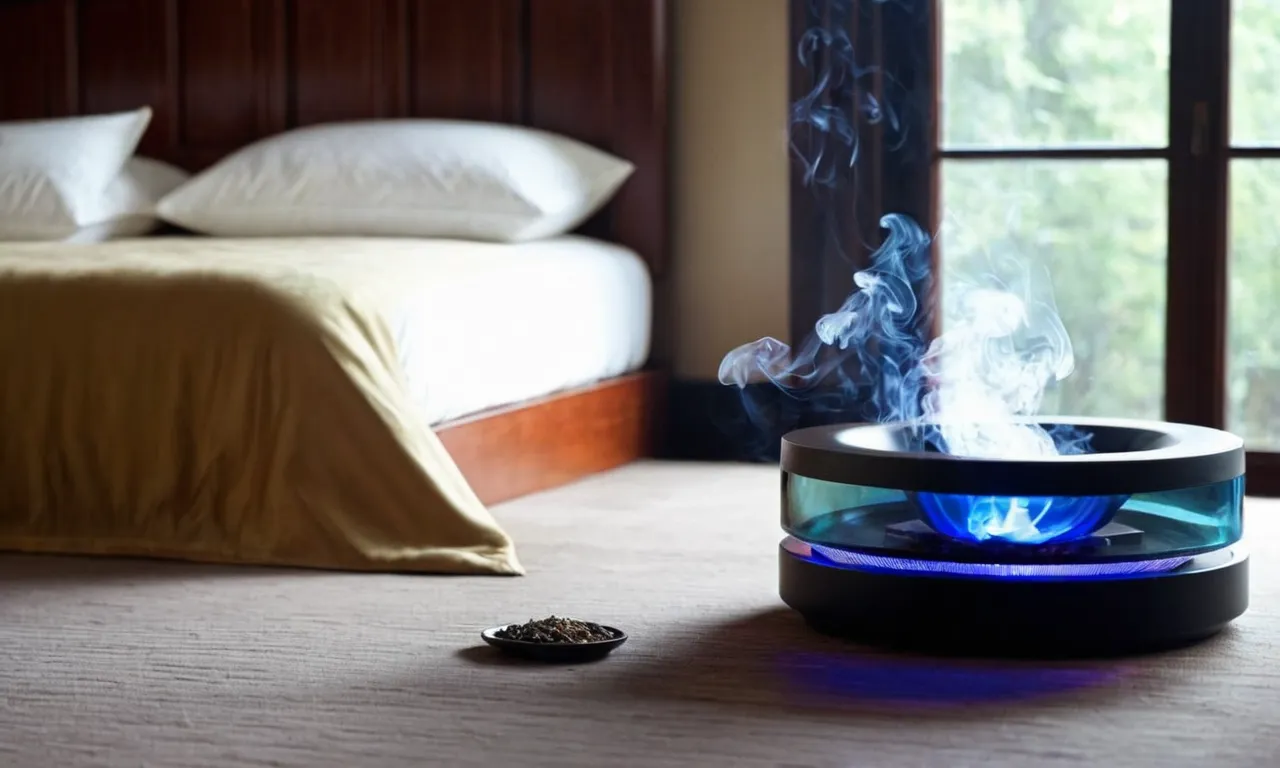Is It Bad To Sleep In A Room That Smells Like Cigarette Smoke?
Cigarette smoke is a potent pollutant that can linger in indoor environments, leaving behind an unpleasant odor and potentially harmful residue. If you find yourself in a situation where your bedroom smells like cigarette smoke, it’s natural to wonder about the potential health implications of sleeping in such an environment.
If you’re short on time, here’s a quick answer to your question: Yes, it is generally considered bad to sleep in a room that smells like cigarette smoke. Exposure to thirdhand smoke, which refers to the residual pollutants left behind by tobacco smoke, can have negative effects on your health, especially with prolonged or frequent exposure.
In this comprehensive article, we’ll delve into the potential risks associated with sleeping in a room that smells like cigarette smoke, explore the components of thirdhand smoke, and provide practical tips for mitigating exposure and improving indoor air quality.
Understanding Thirdhand Smoke
What is Thirdhand Smoke?
While the dangers of firsthand and secondhand smoke are widely known, thirdhand smoke (THS) is a relatively new concept that has gained attention in recent years. THS refers to the residual pollutants that linger in indoor environments after tobacco has been smoked.
These pollutants cling to surfaces, furnishings, and even dust particles, creating a toxic mixture that can persist for months or even years after the initial exposure.
Components of Thirdhand Smoke
Thirdhand smoke is a complex mixture of chemicals, many of which are known to be harmful to human health. Some of the key components include:
- Nicotine: A highly addictive substance that can be absorbed through the skin or ingested.
- Tobacco-specific nitrosamines: Potent carcinogens that have been linked to various types of cancer.
- Polycyclic aromatic hydrocarbons (PAHs): Compounds that can cause DNA damage and potentially lead to cancer.
- Heavy metals: Toxic substances like lead and cadmium that can accumulate in the body.
According to a study published in the journal Environmental Health Perspectives, researchers found that surfaces in homes where smoking occurred contained significantly higher levels of nicotine and other harmful compounds compared to non-smoking homes.
Health Risks of Thirdhand Smoke Exposure
Exposure to thirdhand smoke can have serious health consequences, especially for vulnerable populations like children and individuals with pre-existing respiratory conditions. Some of the potential health risks associated with THS exposure include:
- Respiratory problems: Inhaling the toxic chemicals in THS can exacerbate asthma, cause chronic coughing, and increase the risk of respiratory infections.
- Cancer: The carcinogenic compounds found in THS have been linked to various types of cancer, including lung cancer and breast cancer.
- Developmental issues: Children exposed to THS may experience cognitive and behavioral problems, as well as an increased risk of sudden infant death syndrome (SIDS).
A study published in the Journal of Exposure Science & Environmental Epidemiology found that children living in homes with detectable levels of THS had higher rates of respiratory illnesses and were more likely to miss school due to illness compared to children in non-smoking homes.
While the effects of thirdhand smoke exposure are still being studied, it’s clear that this toxic residue poses a significant health risk, especially in enclosed environments like homes and cars. Taking steps to eliminate THS exposure, such as prohibiting smoking indoors and properly cleaning and ventilating affected areas, can help mitigate these risks and create a healthier living environment for everyone.
Sleeping in a Room with Cigarette Smoke Odor
When it comes to your health, the environment you sleep in plays a crucial role. Cigarette smoke is a potent pollutant that can linger in rooms long after the last puff has been exhaled. Sleeping in a room that smells like cigarette smoke can have significant negative impacts on your well-being, ranging from respiratory issues to an increased risk for certain conditions.
Potential Health Concerns
Cigarette smoke contains a complex mixture of over 7,000 chemicals, many of which are toxic and carcinogenic. Even secondhand exposure to these substances can be harmful. According to the Centers for Disease Control and Prevention (CDC), secondhand smoke exposure causes more than 41,000 deaths among non-smoking adults and 400 deaths among infants each year in the United States alone.
😔
Respiratory Issues
One of the most immediate concerns of sleeping in a smoke-filled room is the potential for respiratory problems. Cigarette smoke can irritate the lungs and airways, leading to coughing, wheezing, and shortness of breath.
For individuals with pre-existing respiratory conditions like asthma or chronic obstructive pulmonary disease (COPD), exposure to cigarette smoke can trigger severe flare-ups and exacerbate symptoms. 🫁
Furthermore, the particulate matter and chemicals found in cigarette smoke can accumulate in the lungs over time, potentially leading to long-term respiratory issues and an increased risk of lung cancer.
A study published in the International Journal of Environmental Research and Public Health found that exposure to secondhand smoke increases the risk of lung cancer by 20-30%. 😷
Increased Risk for Certain Conditions
Beyond respiratory problems, sleeping in a room with cigarette smoke odor can also increase your risk for other health conditions. Secondhand smoke exposure has been linked to an increased risk of heart disease, stroke, and certain types of cancer, such as breast cancer and cervical cancer. 💔
Additionally, children exposed to secondhand smoke are at a higher risk of developing ear infections, respiratory infections, and sudden infant death syndrome (SIDS). According to the CDC, an estimated 7,500 to 15,000 hospitalizations due to respiratory infections in children under 18 months of age are attributed to secondhand smoke exposure each year in the United States.
👶
To minimize the risks associated with sleeping in a room with cigarette smoke odor, it’s essential to take proactive measures to eliminate the source of the smoke and properly ventilate and clean the affected area.
Seeking professional help from air quality specialists or remediation services may be necessary in severe cases. Remember, your health is invaluable, and prioritizing a smoke-free living environment can have a profound impact on your overall well-being. 🌱
Mitigating Exposure to Thirdhand Smoke
Even after the last cigarette has been extinguished and the smoker has left the room, the lingering effects of cigarette smoke can persist. This residue, known as thirdhand smoke, clings to surfaces, furniture, and even walls, posing potential health risks to those who inhabit the space.
Fortunately, there are several effective strategies to mitigate exposure to thirdhand smoke and create a healthier indoor environment.
Thorough Cleaning and Ventilation
The first step in tackling thirdhand smoke is a deep and thorough cleaning of the affected area. This includes washing walls, ceilings, and floors with appropriate cleaning solutions. Carpets, curtains, and upholstered furniture should be professionally cleaned or replaced if necessary.
Additionally, opening windows and doors to increase ventilation can help dissipate any remaining odors and particles. According to the Environmental Protection Agency (EPA), proper ventilation is crucial in reducing indoor air pollutants.
Air Purifiers and Filters
Investing in high-quality air purifiers and filters can be an effective way to remove thirdhand smoke particles from the air. Look for purifiers with HEPA (High-Efficiency Particulate Air) filters, which can capture even the smallest particles.
Additionally, consider installing whole-house air filtration systems or portable air cleaners in heavily affected rooms. The American Lung Association recommends using air purifiers with CADR (Clean Air Delivery Rate) ratings appropriate for the room size.
Replacing Porous Materials
Porous materials like drywall, insulation, and carpeting can absorb and trap thirdhand smoke particles, making it challenging to eliminate the odor and potential health risks. In severe cases, replacing these materials may be necessary to create a truly smoke-free environment.
According to a study published in the Science of the Total Environment, thirdhand smoke can persist in homes for months or even years after smoking has ceased 😮. By replacing porous materials, you can significantly reduce the lingering presence of thirdhand smoke and improve indoor air quality.
Remember, the best way to avoid exposure to thirdhand smoke is to maintain a smoke-free environment from the start. However, if you find yourself in a situation where cigarette smoke has permeated a living space, taking these proactive steps can help mitigate the risks and create a healthier indoor environment for you and your loved ones 👏.
Creating a Smoke-Free Environment
Breathing in secondhand smoke can have serious health consequences, especially for children and those with respiratory conditions. To protect yourself and your loved ones, it’s crucial to create a smoke-free environment at home and in shared spaces. Here are some effective strategies to achieve this:
Establishing Smoke-Free Policies
One of the most effective ways to create a smoke-free environment is to establish clear policies that prohibit smoking inside your home, car, and other enclosed spaces. This not only protects your family from the harmful effects of secondhand smoke but also sets a positive example for children.
According to the Centers for Disease Control and Prevention (CDC), implementing smoke-free policies can significantly reduce exposure to secondhand smoke and the associated health risks.
Educating Others on the Risks
Educating others about the dangers of secondhand smoke can be a powerful tool in promoting a smoke-free environment. Share factual information from reputable sources, such as the Environmental Protection Agency (EPA), about the negative impact of secondhand smoke on health, including increased risk of respiratory infections, heart disease, and lung cancer.
Encourage smokers to quit or, at the very least, refrain from smoking indoors or around non-smokers, especially children. 🙏
Seeking Professional Assistance
If you or someone in your household struggles with smoking addiction, seeking professional assistance can be a game-changer. Quitting smoking is challenging, but with the right support and resources, it’s achievable. Consider reaching out to local smoking cessation programs, healthcare providers, or national organizations like the Smokefree.gov website, which offers free resources and support services.
Don’t hesitate to seek help; your health and the well-being of those around you are worth it. 💪
Creating a smoke-free environment not only protects your family’s health but also contributes to a cleaner and more comfortable living space. By establishing clear policies, educating others, and seeking professional assistance when needed, you can take proactive steps towards a healthier, smoke-free lifestyle.
Remember, every effort counts, and a smoke-free environment is a gift to yourself and your loved ones. 🎉
Conclusion
Sleeping in a room that smells like cigarette smoke is generally not recommended due to the potential health risks associated with exposure to thirdhand smoke. The residual pollutants left behind by tobacco smoke can linger in indoor environments, posing a threat to respiratory health and increasing the risk of certain conditions.
To mitigate exposure and create a healthier living environment, it’s crucial to take proactive steps such as thorough cleaning, ventilation, and the use of air purifiers. Additionally, establishing smoke-free policies and educating others about the risks of thirdhand smoke can help promote a smoke-free environment.
By understanding the dangers of thirdhand smoke and taking appropriate measures, you can protect yourself and your loved ones from the potential negative effects of sleeping in a room that smells like cigarette smoke.
Prioritizing indoor air quality and creating a smoke-free living space is essential for maintaining good health and well-being.








